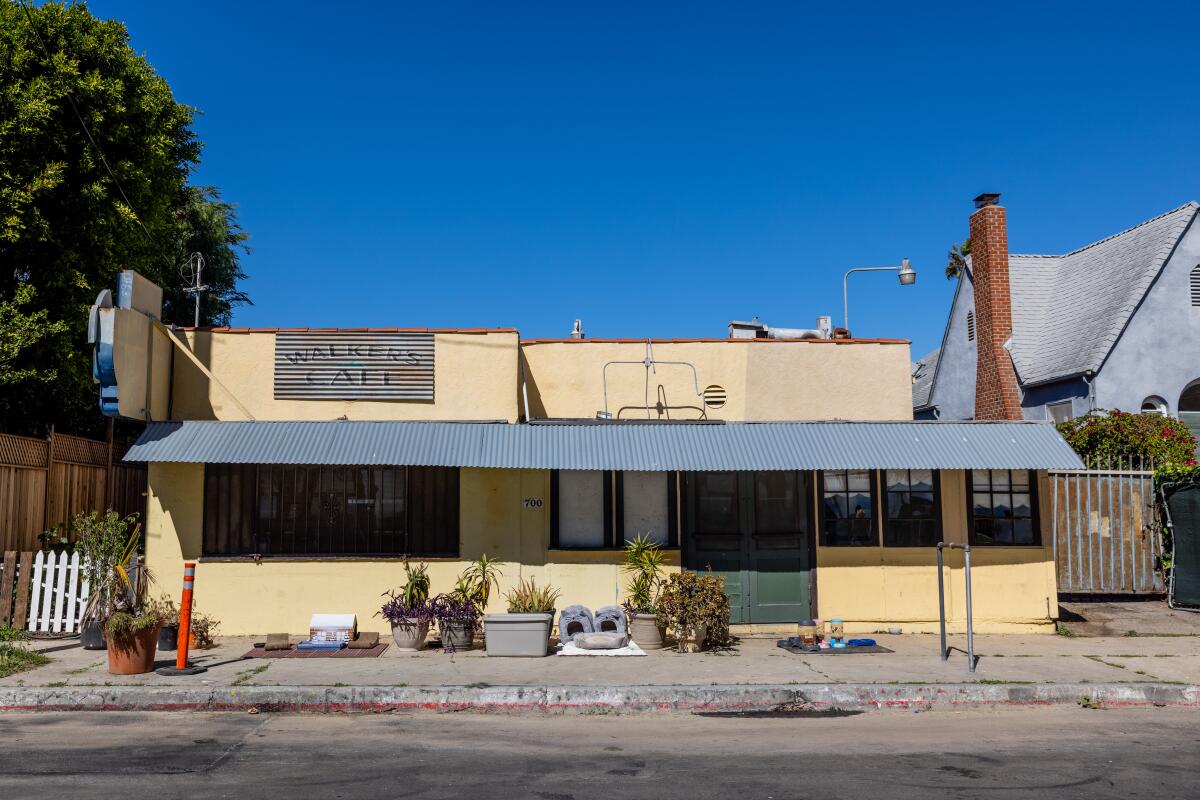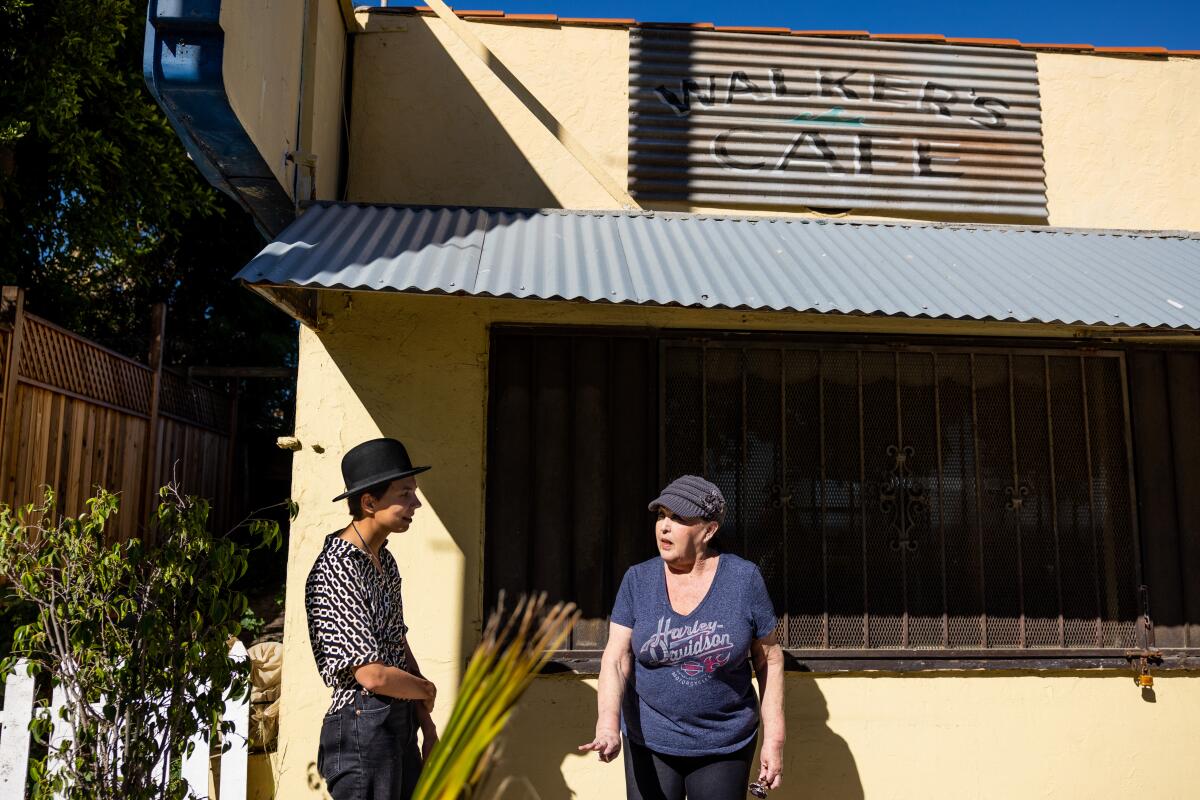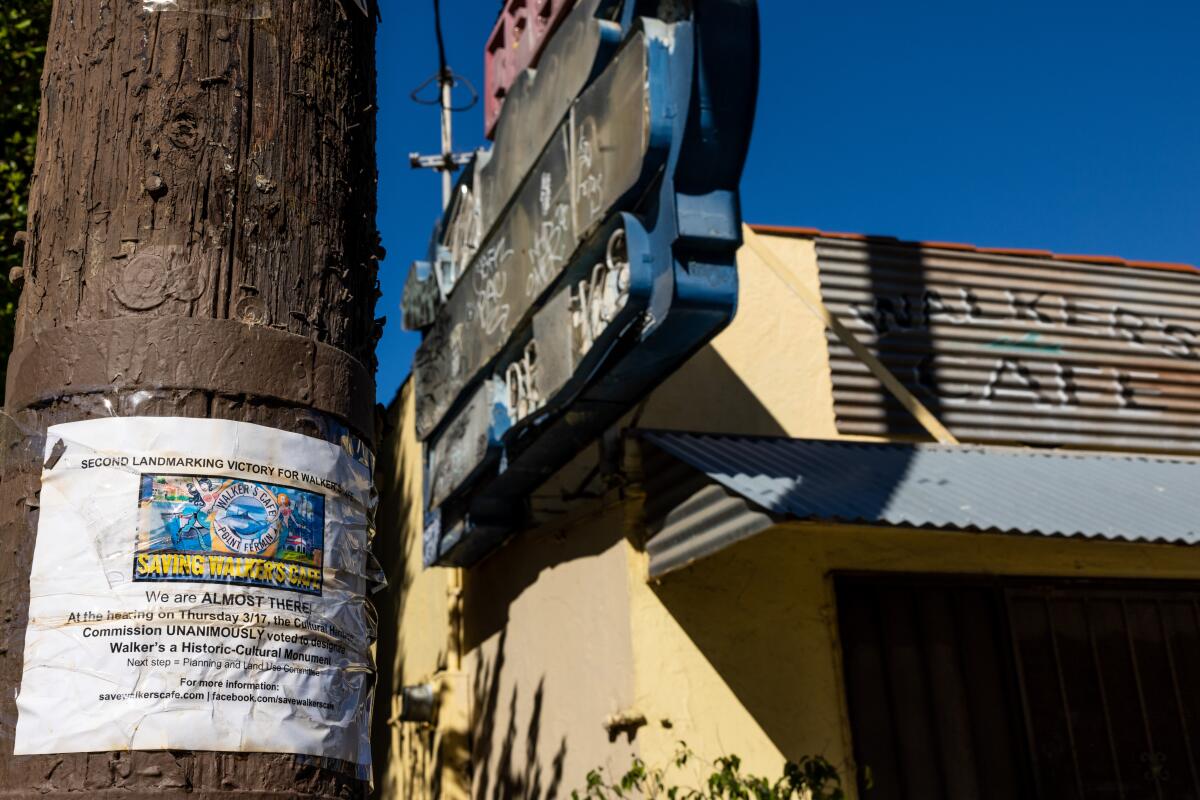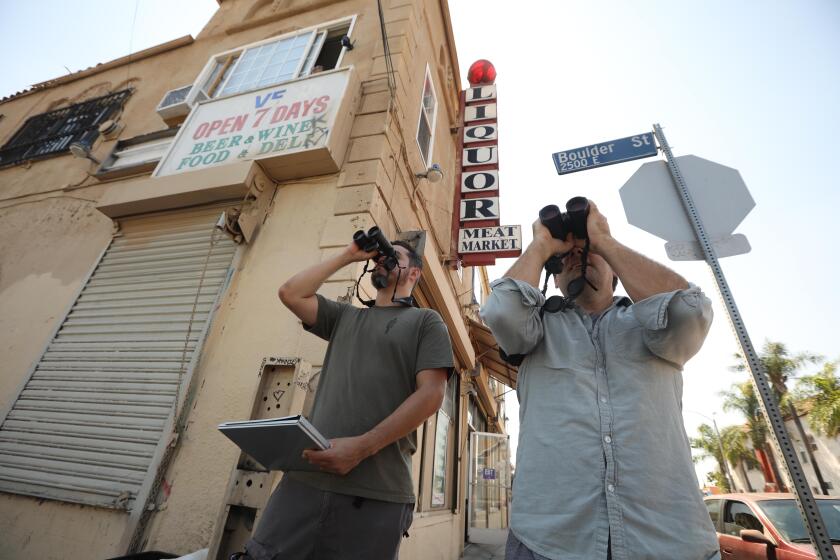An investment group vowed to restore this San Pedro landmark. Neighbors are growing skeptical

- Share via
At the southernmost edge of San Pedro’s coast, tucked away on a residential block near Point Fermin Park, sit the bones of Walker’s Cafe, once a bustling cultural hub where families, longshoremen, merchant marines and motorcycle riders gathered for burgers and cold beers.
A real estate investment group that bought the shuttered property plans to restore it, but its proposal — including the construction of a single-family home with an attached accessory dwelling unit, or ADU, and parking spots — has left the community’s trust in the project wavering.
When the Burbank-based Prospect Group bought the property last year, spokesperson Silva Harapetian told The Times the new owners intended to honor Walker’s history and residents’ wishes by making it a functional, operational business again.
That’s still the owner’s intention, Harapetian said.
“The ideal solution, as the advocates would have it, is to open Walker’s Cafe and have it be what it is, but [the cafe is] a business and [we] have a responsibility to the business; we have a responsibility to our employees but we have equal responsibility to the community, and our job is to balance all of that,” she said.
But San Pedro neighbors and fans of Walker’s Cafe are skeptical.
A new study found evidence that income inequality and historic redlining affect the types of birds people experience across Los Angeles County.
Emma Rault, who spearheaded a campaign to save the restaurant and have it designated a Los Angeles historic-cultural monument, said she wants Walker’s Cafe “to have a chance” but feels that Prospect Group’s current proposal is setting it up to fail.
Among the reasons for her doubt, Rault said, is the wait of more than a year for Prospect Group’s plans to reopen the restaurant, which it shared at a buzzing Oct. 4 meeting of the Coastal San Pedro Neighborhood Council.
During that time, she said, she worked to connect prospective restaurant operators with the new owner, but none was persuaded.
Previous potential operators The Times spoke to including Joshua Knight, owner of Coffee Parlor in Long Beach, said the proposed lease price and the out-of-pocket costs needed to invest in upgrading the kitchen area to make it a viable space dissuaded them from moving forward with Prospect Group.
Rault, a native of the Netherlands, was drawn to move to San Pedro shortly before the pandemic in part because of the history and sense of community around places such as Walker’s Cafe.
It’s the kind of place that stays with San Pedrans for life. At a recent council meeting, fourth-generation San Pedro resident Ginger Dearborn said her mother had brought her to Walker’s Cafe since she was 3 years old; she later worked as a waitress, and three years ago she had her father’s funeral services there.

When the restaurant closed without much explanation in October 2021, after being open sporadically through the pandemic, Rault launched a petition to gauge community interest in saving it.
“I realized what was at stake because it’s so easy when a place closes or when it’s going through some kind of transition or when it changes hands … for a place to just slip through the cracks and be lost,” said Rault, a writer and translator by trade. “There’s no getting that back.”
The petition garnered over 3,000 signatures, and in the fall of last year, Walker’s Cafe was designated a Los Angeles historic-cultural monument. Such designations allow the city’s Cultural Heritage Commission to delay any planned demolition of a historically significant building while it weighs preservation options.
Supporters of Walker’s Cafe are eager to retain its historic features, especially in the face of community changes that longtime San Pedrans say have been eroding the neighborhood’s character for decades.
The property was constructed in 1935 and purchased by Raymond J. Walker and Bessie Mae Petersen in 1946, according to a recommendation report by the city of Los Angeles’ planning department.
The married couple opened Walker’s Cafe with an expanded dining room in what was previously an attached apartment and operated the restaurant together until Walker’s death in 1953, when Petersen’s sister stepped in to assist, the report states.
The San Pedro Fish Market and Restaurant will close its location in the Ports O’ Call Village in March. The restaurant plans to remain in San Pedro.
Petersen “established herself as a fixture of community life in San Pedro, known for providing meals to anyone regardless of their ability to pay,” according to the report. After she retired in 1994 and then died two years later, her son, Richard Brummett, and his wife took over the business.
By then, a major shift in San Pedro had long taken hold: the loss of a lively downtown filled with small, family-run businesses as residents flocked instead to malls in Torrance and other developments that started opening around the South Bay in the 1960s.
“In losing that core, downtown, vibrant retail center, we said goodbye to something that was really important,” Mona Dallas Reddick, president of the San Pedro Bay Historical Society, told The Times last year. “I think people my age, and even a bit younger, haven’t ever gotten over that.”
With a new wave of development giving rise to apartments and other modern buildings lining parts of downtown, many San Pedro residents “are really feeling a sense of displacement in their own community” and worry that developers are ignoring their wishes and community guides, Reddick said.
At last week’s neighborhood council meeting, supporters of Walker’s Cafe raised concerns about “unpermitted work” that they said began once Prospect Group put a fence around the cafe, which resulted in a work-stop order by the Los Angeles Department of Building and Safety.
Harapetian said Prospect Group spent a significant amount of time going through trash that had accumulated throughout the property because “we didn’t want to throw away a important historical item,” and put up the fence after having issues with break-ins.
Prospect Group also replaced two boarded-up back windows that aren’t part of the historical aspects of the building, installed a security alarm and covered an open skylight, all to protect the building, Harapetian said.
“The alternative of risking the cafe was worse than taking the brunt of the blows of them calling it illegal work,” she said.
Since Prospect Group bought the property in March 2022, Harapetian said, it has been working with the city’s Office of Historic Resources and a hired historical consultant.
The group’s focus now, Harapetian said, is how to bring Walker’s Cafe back as a strong business, even if it requires some changes to the building. “We have learned a lot about what is going to be required for an operator to run a successful cafe,” she said.
“Every day we all wait to have a hamburger at Walker’s is another day invested into Walker’s,” Harapetian said.
As those days drag on, some unique features of the cafe have been lost.

The remains of a neon sign hang outside, broken and bearing the scars of graffiti. Murals of cartoon characters painted decades ago by an unhoused merchant marine in exchange for shelter were painted over at some point before the property was sold, Harapetian said.
The new owners are holding onto as much of the original memorabilia as they can, she said, and hope to replicate some of what was lost.
But like any good Los Angeles landmark, Walker’s Cafe is immortalized on screen; the restaurant has appeared in films including “Chinatown,” “Gods and Monsters” and “Inherent Vice.”
Robert Towne, writer of “Chinatown,” compared the preservation battle to what he called “the truly murderous act” at the center of his screenplay: “laying waste to California’s land and fragile communities as an incidental part of a respectable man’s grand vision.”
“The movie for me was always about returning to the places that stuck in my mind from my own childhood, and in doing so preserve them for the future,” Towne said in an email.
“And so Walker’s Cafe has been lighting up screens around the world for almost fifty years,” he said, “and it would be a tragedy if San Pedro were to lose it.”
Times staff writer Gregory Yee began reporting on Walker’s Cafe before his death in January. Staff writer Karen Garcia finished the reporting and writing in October.
More to Read
Sign up for Essential California
The most important California stories and recommendations in your inbox every morning.
You may occasionally receive promotional content from the Los Angeles Times.

















